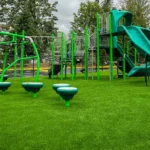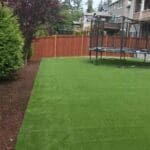As winter approaches, preparing your synthetic turf for the colder months is essential to ensure its longevity and maintain its aesthetic appeal. While synthetic turf is known for its low-maintenance characteristics, a little extra care can go a long way in preserving its beauty and functionality. In this guide, we’ll walk you through the steps to winterize your synthetic turf, keeping it lush and green despite the chilly temperatures.
Cleaning Thoroughly
- Utilize a leaf blower or a stiff brush for effective debris, leaves, and dirt removal
- Consider our maintenance program for a hassle-free experience
Before winter sets in, initiating the winterization process with a thorough cleaning is a good idea. Use a leaf blower or a stiff brush to gently sweep away debris, leaves, and dirt, paying special attention to high-traffic areas. This enhances the appearance and prevents issues during the colder months. Enrolling in our maintenance program provides an added layer of convenience, ensuring that we handle the cleaning process with expertise.
Weeds and Moss in The Pacific Northwest
- Regularly inspect for signs of weeds or moss growth
- Use weed and moss killer or manually remove growth to prevent issues.
In the Pacific Northwest, where the climate encourages moisture, regular inspections for signs of weeds or moss are key. While synthetic turf is designed to resist these issues, occasional intrusions can occur. Utilize a weed and moss killer or manually remove any growth to prevent them from establishing during the winter. Additionally, you can consider applying a preventative treatment to inhibit the growth of these unwanted occurrences.
Check for Drainage Issues
- Ensure proper drainage for clogs or blockages
- Protect turf from potential damage caused by water pooling on the surface
Proper drainage is important, especially in the winter when rainfall is common and there is a potential for snow. Try to give a good check of the drainage system to ensure it is free from any clogs or blockages. In addition to storm drains and yard drains, inspect the overall function of your landscape to encourage proper water flow away from the turf. Proper drainage not only protects the turf from damage but also ensures the longevity of the underlying materials.
Apply Antimicrobial Treatment and Brush Up the Fibers
- Prevent bacteria and fungi growth by applying an antimicrobial treatment
- Strengthen compacted fibers, especially in high-traffic areas, using a stiff brush.
Revive and clean your turf by using a stiff brush to fluff up the fibers, restoring the natural appearance. Beyond visual appeal, this action maintains the turf’s strength for potential snow or extreme weather conditions. You can also apply an antimicrobial treatment to ward off bacteria and fungi growth.
Protect Against Heavy Loads
- Avoid placing heavy objects on turf, especially in freezing conditions.
- Slide heavier objects with the grain of the turf and compress blades uniformly.
While synthetic turf is designed to withstand various weather conditions, it’s wise to minimize the impact of heavy loads during winter. Steer clear of placing heavy objects directly on the turf, particularly in freezing conditions, as this can potentially damage the fibers. Instead, consider utilizing designated walkways or paths in high-traffic areas to distribute the load more evenly. For unavoidable heavy items, employ a strategic approach by sliding them with the grain of the turf. This technique ensures that all turf blades are compressed uniformly, minimizing the risk of damage.
Snow Removal Tips
- If you would like you can remove snow using a plastic shovel or leaf blower
- Avoid metal tools that could damage fibers, and refrain from using ice melt products with calcium chloride. Opt for alternative ice melt products that are turf-friendly or use sand for traction on icy surfaces.
During snow removal, prioritize clearing pathways and common areas first to reduce. Consider investing in snow blankets or covers specifically designed for synthetic turf. These covers provide an extra layer of protection against freezing temperatures and can expedite the melting process when exposed to sunlight. When manually removing snow, avoid using tools with sharp edges or metal components that may scratch or cut the turf fibers. A gentle and careful approach is key to maintaining the turf’s aesthetics and functionality.
Repairs
- Contact Synthetic Turf Northwest’s repair team for any damage to the turf or gravel base. You can fill out a care and repair request on our website.
- Benefit from a dedicated team with expert knowledge to address your needs promptly.
In addition to addressing visible damage, consider doing a thorough look over the turf infill. Over time, infill materials may settle or shift, affecting the turf’s performance. Investing in periodic infill maintenance, either through our services or DIY methods, ensures the even distribution of infill, contributing to the overall stability of the synthetic turf system. You can also purchase the infill at the shop if you are interested.





